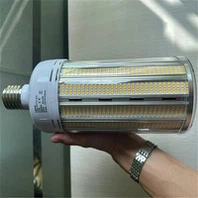In transportation infrastructure, tunnels play essential roles in anything from busy highways to underground metro systems. Tunnel lighting is essential for safety, energy efficiency, and regulatory compliance; it is not just ornamental. Whether vehicles are flying through highway tunnels or people are traversing subway stations, selecting the appropriate LED tunnel lighting guarantees visibility, reduces the risk of accidents, and promotes efficient traffic flow.
However, why is tunnel illumination so important in these many settings? Let's dissect the fundamentals.
Why Tunnel Lighting Matters
Safety: Avoiding Mishaps and Maintaining Eye Clarity
The main justification for spending money on efficient tunnel lighting is simple: safety. Drivers see a sharp change in illumination when they enter a tunnel, which, if not controlled, can result in a hazardous situation called the "black hole effect." This occurs when the entrance appears too dark in comparison to the surrounding environment, momentarily blinding vehicles. By removing these abrupt visual changes, proper tunnel illumination greatly lowers the danger of accidents.
Issues with Energy Use in Extended Tunnels
Energy consumption is a major consideration when it comes to tunnel lighting, particularly for long sections where lights are left on all the time. Energy resources are rapidly depleted by outdated lighting technology like fluorescent bulbs and sodium vapor. Municipalities can significantly reduce their operational expenses and environmental effect by implementing energy-efficient LED tunnel lights. Compared to conventional lighting, LEDs often consume up to 75% less electricity, which lowers energy costs and carbon emissions.
Transportation Infrastructure Regulatory Compliance
Strict rules and safety requirements must be followed when building infrastructure. Clear standards for tunnel lighting are set by organizations like the International Commission on Illumination (CIE) and the American Association of State Highway and Transportation Officials (AASHTO). LED tunnel lighting that is properly planned and installed satisfies or surpasses these requirements, guaranteeing compliance and preventing expensive fines.
Reducing "Black Hole" or "Flicker" Effects with Consistency
It is crucial that the lighting levels in a tunnel remain constant. Drivers and pedestrians may become confused, disoriented, and at risk due to uneven lighting, flicker, or shadows. Superior LED tunnel lighting provides consistent illumination and steady light output, removing hazardous flicker effects, lowering eye strain, and greatly enhancing tunnel safety in general.
Now that its significance has been established, let's examine its distinct functions in different tunnel conditions in the sections that follow.
Key Features of Effective Tunnel Lighting
Selecting fixtures with particular qualities that guarantee superior performance, safety, and dependability is necessary to choose the best LED tunnel lighting. The following are crucial factors to take into account while assessing tunnel illumination options:
Uniform Light Distribution and High Lumen Output
To keep tunnel visibility clear, a high brightness output is essential. The brightness of inside illumination and daylight outside tunnels frequently differs significantly. High lumen output fixtures aid in balancing these variations in lighting. Furthermore, consistent lighting distribution eliminates hazardous dark patches and excessively bright places, guaranteeing that walkers, drivers, and maintenance workers can see their surroundings and potential dangers with clarity.
Low Flicker and Glare Control
Because too much glare can impede vision and create dangerous conditions, glare reduction is crucial in tunnel environments. High-quality LED tunnel lights have anti-glare optics and specific lenses that reduce harsh reflections by precisely directing and diffusing light where it is needed. Additionally, low flicker technology improves visual comfort, lessens eye strain, and lessens fatigue-all of which are crucial for pedestrians spending a lot of time below or drivers negotiating lengthy tunnels.
Dust and Water Protection IP Ratings
Due to the exposure of lighting fixtures to dust, grime, moisture, and humidity, tunnel settings can be quite difficult. A fixture's resistance to these external variables is indicated by its Ingress Protection (IP) rating. Generally speaking, effective tunnel lights have an IP65 grade or higher. This certification guarantees superior defense against water jets, moisture intrusion, and dust buildup, enabling fixtures to function consistently and dependably even in challenging circumstances.
Impact Resistance IK Ratings
For tunnel illumination, impact resistance is essential, especially in public spaces like pedestrian underpasses and walkways that are vulnerable to vandalism or unintentional damage. A fixture's robustness to physical impacts and longevity are gauged by its IK rating. Typically, tunnel lighting fixtures are rated IK08 or IK10. While IK10 fixtures provide the highest level of security, thwarting even the most extreme attempts at vandalism, IK08-rated lights can tolerate modest hits, guaranteeing longevity and lower maintenance costs.
Compatibility between dimming and smart controls
Modern LED tunnel lighting fixtures integrate with smart control systems and allow dimming. This type of technology allows for changing lighting according to current circumstances, such as traffic volume, daylight levels, or emergencies. Additionally, remote monitoring is made possible via smart controls, allowing for preventive maintenance and prompt reaction to fixture failures or shifting conditions. These features lower operating expenses while improving long-term dependability, operational safety, and energy efficiency.
Tunnel managers can choose lighting solutions that reliably provide safety, effectiveness, and durability in a variety of tunnel situations by concentrating on these essential characteristics.
Tunnel Lighting by Environment
The illumination needs of various tunnel conditions vary. Let's examine important lighting factors and the best items for each unique environment.
Roadway and Highway Tunnels
Focus: High-speed traffic visibility.
Clear and steady vision is essential when driving at high speeds. Drivers must enter the tunnel environment without experiencing any visual discomfort or loss of clarity.
Important Points to Remember:
Luminance transitions: To provide gentle adaptations to varying brightness levels, effective luminance management is essential, particularly at tunnel entrances and exits.
Beam angles: Properly chosen beam angles minimize shadows and dark areas and guarantee uniform coverage.
Anti-glare optics: Specialized lenses lessen the possibility of being blinded by headlamp glare or reflections on damp roads.
Ideal Products: Dimmable drivers for smooth brightness changes, energy efficiency, and improved visibility in high-output linear or modular LED tunnel lights.
Subway Tunnels and Stations
Focus: Pedestrian visibility, maintenance access, and aesthetics.
In subway environments, lighting isn't just practical-it's also a crucial design element that affects the user experience. Bright, clear illumination ensures pedestrians feel safe, while aesthetically pleasing designs enhance the overall appeal of public transportation infrastructure.
Key Considerations:
Low-glare fixtures: Essential for pedestrian comfort, reducing eye fatigue during prolonged exposure.
Emergency lighting integration: Ensures safety during power outages or emergencies, clearly marking exits and escape routes.
Motion sensors: Save energy by automatically dimming lighting when areas are unoccupied, improving efficiency and reducing maintenance frequency.
Ideal Products: Surface-mounted or recessed LED tunnel lights equipped with built-in emergency battery backups and integrated motion sensors to maximize safety and comfort.
Tunnels for Rail and Freight
Emphasis: Equipment inspection and operational safety.
Reliable lighting is essential for both safe operations and efficient maintenance inspections in rail and freight tunnels. In order to clearly illuminate tracks, signage, and important infrastructure elements, lighting must be able to endure extreme weather and vibrations.
Important Points to Remember:
Reliability in settings with heavy machinery and frequent train movements depends on vibration resistance.
Directional beam control: Accurate lighting focuses on certain regions, supporting thorough inspections and overall operation control.
A high color rendering index, or CRI, guarantees precise color visibility, which is essential for maintenance or inspection duties where color separation is essential.
Ideal Products: Rigid linear fixtures or adjustable LED tunnel floodlights that offer robust, focused illumination appropriate for harsh train applications.
Understanding the unique lighting requirements of various settings allows us to see how focused LED solutions significantly improve user experience, safety, and efficiency in tunnels of all kinds.
Let's now examine the practical parts of installation and upkeep to ensure the long-term efficacy of your tunnel lighting.
Advantages of LED Tunnel Lights Across Environments
From pedestrian underpasses to high-speed roads, LED tunnel lights continuously perform better than conventional lighting technologies in all sorts of tunnels. Let's examine the reasons why LED lighting options are so advantageous in a range of settings:
Greater longevity (100,000–150,000+ hours)
The exceptionally long lifespan of LED tunnel lighting is one of the strongest arguments for making the switch. The average lifespan of an LED fixture is 100,000–150,000 hours or more. LEDs offer exceptional long-term durability, significantly lowering the frequency and expense of replacements as compared to conventional High-Intensity Discharge (HID) lighting, which may only last 15,000 to 25,000 hours.
Up to 70% less energy is used than with HID.
Compared to conventional HID bulbs, LED tunnel lighting often uses up to 70% less energy. This decrease directly results in decreased energy costs, which is advantageous for longer tunnels that need constant lighting. By drastically reducing the carbon footprint of transportation infrastructure, energy-efficient LEDs also contribute to sustainability objectives.
Reduced Maintenance Expenses in Tunnels with Limited Access
Tunnel maintenance is expensive, disruptive, and even dangerous, especially for high-speed roads or subway systems. Because LED tunnel lights are so durable, they require less frequent maintenance, which lowers labor costs, minimizes closures, and increases infrastructure availability overall. For maintenance crews, fewer replacements translate into fewer interruptions and lower hazards.
Lighting Controls That Can Be Customized (Smart Lighting Integration)
With dimming settings and sophisticated lighting controls that may be customized, LED tunnel lighting is incredibly versatile. LEDs can automatically adapt to variations in traffic volume, weather, or daylight levels through integrated control systems, maximizing efficiency and safety. This kind of adaptability improves reactivity to changing situations, optimizes energy savings, and offers handy remote monitoring.
Eco-friendly (lower carbon footprint, no mercury)
In contrast to traditional lighting sources, LEDs are free of dangerous gasses and chemicals like mercury. Because of this, LED tunnel lights are environmentally benign, greatly lowering waste and pollution levels over the course of their lifetime. LEDs significantly lessen the carbon footprint of any tunnel lighting installation when combined with their lower energy consumption.
Frequently Asked Questions
In conclusion, the following are brief responses to frequently asked issues concerning LED tunnel lighting:
Which color temperature works best for tunnel lighting?
Tunnel lighting fixtures are usually chosen between 4000K and 5000K. Excellent visibility, crisp color rendering, and less eye strain are provided by its neutral white color temperature, making it perfect for maintenance tasks, pedestrian safety, and safe driving.
How do LED tunnel lights fare in harsh environments?
Superior LED tunnel lights are made to survive harsh conditions. Because of their sturdy housing designs, high IP and IK ratings, and long-lasting materials, these fixtures are designed to withstand intense heat, humidity, wetness, and constant vibration. This guarantees dependable functioning even in difficult environments.
Is it possible to automate tunnel lighting?
Of course! Smart lighting controls can and should be used to automate modern tunnel illumination. Lighting may react dynamically to situations in real time thanks to systems with sensors, adaptive dimming, and remote monitoring, which enhances safety, energy efficiency, and maintenance simplicity.
http://www.benweilight.com/industrial-lighting/led-flood-light/led-powed-wall-flood-lights.html
Our address
No. 5-3 Niujiao Road, Yanchuan Community, Yanluo Street, Bao'an District, Shenzhen
Phone Number
+86 18659785153
bwzm04@ledbenweilighting.com











